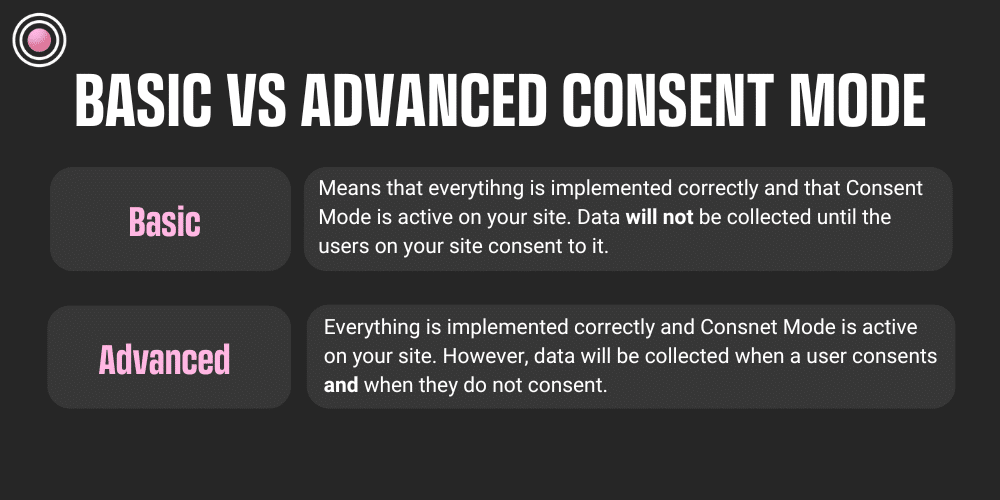
-
ROAR
- 4 Min Read
- Blog, Tracking and Analytics, Website
What is Google Consent Mode V2?
Google Consent Mode V2 has been announced, and with it, new requirements for personalised ads in Europe.
As of March, existing Consent Mode Implementations will require an update to maintain targeting capabilities for advertisement purposes.
What’s the Significance of Google Consent Mode?
Google Consent Mode was introduced in 2020 to help the search giant maintain its digital advertising business in line with the increased demand for user privacy regulations and data protection legislation. 2020 was a year marked by increased concern over data privacy and protection, ultimately leading to trouble for Google.
Following a lull in data breaches, 2021 was a markedly terrible year for personal data. Many of these consent and user privacy changes have been a long time coming. With Google being a large part of the internet, it was about time that something like Consent Mode came along.
Contrary to a lot of online information, consent mode only refers to Google services. Consent mode is effectively a tool that helps marketers bridge the gap between data privacy and data-driven marketing. The main aim is to help collect user data on Google services while also considering the user’s consent preference.
When a user either consents or opts out of cookies related to Google’s products and services, Consent Mode helps decide whether to collect full data (when a user opts in) or to collect only anonymised data (when a user opts out). This helps make your data collection Google-compliant but will not solve most websites’ larger cookie and consent issues. You won’t be fully compliant if all you do is set up Google Consent Mode.
Consent Mode V2 vs Consent Mode V1
It’s probably more prudent to look at versions one and two as the same tool; version two is in fact one of many potential updates. Consent mode was built primarily to more accurately collect signals from users who have not consented to personal data collection, and therefore alter how some Google services behave. Google Consent mode V2 has added more of these signals, and they act more as an instruction for Google services that want to use this data for advertising purposes.
Version two has also come with more defined concepts for Consent Mode implementation. These being Advanced Consent Mode and Basic Consent Mode.
Basic Consent Mode
When referring to Basic Consent Mode, this means that you have implemented everything correctly and that Consent Mode is active on your website. Data will not be collected until the users on your site consent to it.
Advanced Consent Mode
Advanced Consent Mode means that you have implemented everything correctly and Consent Mode is active on your website. However, data will be collected when a user consents and when they do not consent.
Consent Mode is a complex topic to those you do not live and breathe in the world of website tracking and analytics. If you are struggling with your implementation of Google Consent Mode V2, then please get in touch with ROAR and explore how we can help you.
I’ve Barely Heard of Consent Mode, and Now There’s a Version 2?
Google Consent Mode has actually been available for Google service users in a very basic form since 2020. The introduction was, by and large, forced by concerns that Google’s data collection violates data privacy. These concerns came from reports of how it had collected and continues to collect data from users from all across the internet.
Consent mode is one of many features they are putting in place to help combat these concerns. Version 2 is just a new addition to this tool, and many more updates are sure to come. To stay up to date in the future, we’d recommend you use Google’s security and privacy hub.
Do You Need Google Consent Mode V2?
To put it as simply as possible, if you are using Google services such as Google Ads or Google Analytics 4 in Europe or the UK to collect data for advertising purposes then you will need to upgrade to Google Consent Mode V2.
If you are not compliant with Google’s standards for compliance after March 2024 this data will no longer be available to you. Subsequently, you may see an impact in the performance of your personalised Google Ads campaigns.
The Advantages of Google Consent Mode V2
If you fail to comply with Google Consent Mode V2 then this may not only jeopardise your ability to gather data for advertising but will also deprive you of valuable modelling data for analytics purposes.
Version 2 uses machine learning where it cannot collect data from users who have not consented in its conversion modelling for website analytics against users that have consented. Despite this imperfection, AI data modelling can be a helpful tool to reconstruct conversion models that might otherwise be lost.
This is far from the perfect fix for marketers, in fact, both versions of Consent Mode are debated quite intensely online. With many seeing it as a necessary, unavoidable nuisance but with others stating that
What You Need to Do
If you are collecting data for personalised advertising purposes then we would highly recommend that you begin implementing version 2 as soon as possible. There are many avenues that you can explore to fully implement it, you need to find the best option for your business.
Key Takeaways
- Google Consent Mode V2 has been introduced specifically for data collected for personalised ads, requiring updates to existing implementations.
- V2 bridges the gap between data privacy and marketing for Google services only, to help respect user consent.
- Version 2 is the same as version 1, it just builds upon the previous iteration and brings the two concepts of basic and advanced implementation.
- Compliance is essential for businesses using Google services in Europe and the UK, this is to help avoid data unavailability and a negative Google Ads advertising campaign performance.
- Version 2 is crucial for maintaining data collection, despite debates that state otherwise online. It offers benefits from their machine learning conversion modelling and reconstruction of data that would normally be lost without consent.
Our Website Analytics and Tracking Services allow your business to unlock valuable insights about your website performance. Learn more here!






